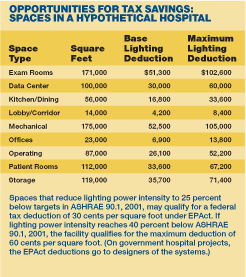For-profit and Government Hospitals Can Earn Tax Deductions for New Construction and Renovations
The recent debate on the U.S. health care system has focused a lot of attention on the high cost of hospital care in this country. Rarely mentioned in those discussions is the fact that energy costs are one of the larger controllable costs for hospitals. It is estimated that U.S. hospitals spend more than $6.5 billion annually on energy costs, which is equal to about 15 percent of hospital profits.
As a result of their 24/7 operation, patient comfort and other needs, hospitals use about 2.5 times the amount of energy as similarly sized commercial buildings. Recognizing this huge opportunity in the hospital energy cost area, the U.S. Department of Energy (DOE) recently announced the Hospital Energy Alliance to help drive energy efficiency in hospitals.
As a group, hospitals are well behind other building categories in addressing energy reduction. Upgrading lighting is one of the easiest major energy reduction opportunities for hospitals to act on. A hospital facility manager considering a lighting or other energy upgrade is well-advised to be aware of the possibility of a federal tax deduction for energy improvements that meet targets specified in the Energy Policy Act of 2005 (EPAct).
For-profit hospitals are eligible for tax deductions of up to 60 cents per square foot under the Energy Policy Act (Section 179(D) of the Internal Revenue Code) for energy efficient lighting. Government hospitals — Veterans Administration hospitals, as well as state, county and city hospitals — cannot take the tax deductions themselves, but can pass along Section 179(D) tax deductions for the architects, engineers, lighting designers, and design and build electricians that design qualifying energy efficient lighting.
Deductions are available for new construction as well as upgrade projects.
EPAct deductions are based on reductions of energy use below levels spelled out in ASHRAE 90.1, 2001. For a reduction in lighting power density of 25 percent below the requirements of ASHRAE 90.1, 2001, a facility is eligible for a deduction of 30 cents per square foot for the space where the upgrade took place. As the reduction in lighting power density increases, the deduction also rises, reaching a maximum of 60 cents per square foot for a 40 percent reduction in lighting power density.
Facilities must also meet two other EPAct requirements to qualify for the lighting tax deduction:
- Facilities must provide minimum IESNA light levels.
- Facilities must have bi-level switching in all spaces. That means a facility must provide at least two levels of light, in addition to off, in all areas surrounded by floor-to-ceiling walls.
EPAct deductions of up to 60 cents per square foot are also available for both the HVAC system and the building envelope. Obtaining those deductions requires modeling with a program approved by the Internal Revenue Service. The deductions for lighting can often be obtained without modeling, using a prescriptive method based on watts per square foot. For lighting, modeling can also be used to show a 16.67 percent reduction in energy costs compared to costs associated with ASHRAE 90.1, 2001. For lighting controls, modeling is required to obtain EPAct tax deductions.
Modeling is less an obstacle to EPAct deductions than in the past. One reason is that the number of modeling programs approved by the Internal Revenue Service has grown. Another factor is the popularity of the LEED green building rating system, which also requires modeling. A third factor is that modeling capabilities are becoming more widespread as a new generation of architects, engineers and designers enters the workforce.
Download PDF

Related Topics:














